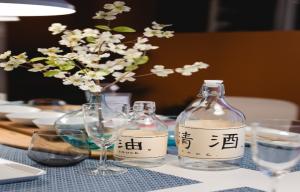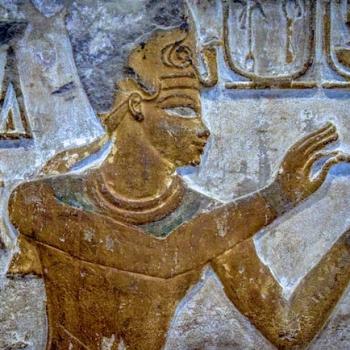
Image via Jason Leung on Unsplash
Sake is a popular drink worldwide, but it originated in Japan to serve various purposes. What does sake symbolize today? Read this guide to learn everything you need to know about the drink and its symbolic meanings in Shinto rituals.
The Drink of the Gods: Sake’s History
Rice has been a critical crop in Japan for thousands of years. In addition to being a crucial part of daily diets, it’s also easy to ferment. Fermented rice turns into sake, also known as Japanese rice wine.
The earliest written records of sake point to people brewing it in the Heijo palace around the eighth century. It was likely made long before the written record, given that historians found evidence of rice paddies made 6,000 years ago during the Jōmon period. Written records are formal accounting, so historians use them as the official record.
Sake merged with mythology when the legend of Susano-o appeared in 712 A.D. in the Kojiki. The book recorded the Japanese imperial court’s knowledge of how Japan began. It contains myths, songs and legends like that of Susanoo-no-Mikoto, also known as Susano-o.
Susano-o was the god of fields, storms and the sea. As a kami, he assisted with farming and harvesting while fighting legendary figures like the sea serpent Yamata-no-Orochi.
The Kojiki describes a family who lost seven of their eight daughters to Yamata-no-Orochi. In return for slaying the eight-headed monster, Susano-o requested eight brewed vats of sake to tempt the sea serpent into getting drunk. Once the snake drank all the sake, it was too intoxicated to fight. Susano-o killed it and saved the family’s remaining daughter, Princess Kushiada.
Since the publication of this myth, people integrated sake into the Shinto religion. It’s an indigenous religion of Japan that still exists today. Modern Shintoists have multiple sake rituals because the drink symbolizes numerous essential things in their faith.
What Does Sake Symbolize?
Sake symbolizes four primary concepts in Shinto rituals. These are the meanings that matter most within the religion.
Purification
Sake is an earthy element because it comes from rice. Shintoists believe it’s a gift from the nature-bound kami and contains divine power. When consumed, the power purifies believers during religious ceremonies.
Fertility
Sake can also represent the gift of fertility. Couples who want to conceive may drink sake in a fertility ritual to ask the kami for their blessing. Given that female fertility declines drastically by age 32, people in that age range may combine this Shinto ritual with modern medicine to find greater peace during their conception process.
Good Fortune
Shintoists may drink sake to symbolize a request for good fortune. It used to apply mostly to bountiful harvests when Shinto rituals began but now applies to requests for great success in new personal or professional ventures.
Strength
Some sake drinkers look to it as a symbol of strength. If you’re facing a challenge or going through difficulties, a private sake ritual could represent beseeching the kami for renewed strength.
Rituals Using Sake
Shintoists believe sake is a crucial bond between deities and humans. It’s a form of communication with the gods, so these are the primary rituals people follow in times of need or thanks.
Kagami-Biraki
Sake symbolizes communication with the Shinto gods. The New Year’s Kagami-biraki ceremony features a barrel of sake and a wooden mallet. When someone strikes the barrel with the mallet and serves the sake to ritual attendees, it’s a sign they’re asking the gods for excellent fortune and health over the coming months.
San-San-Kudo
When Shintoists get married in a traditional ceremony, they ask a Shinto priest to conduct the san-san-kudo ritual. The priest fills three cups with sake and stacks them vertically. The bride and groom each sip from the three cups. The groom’s parents do the same and the bride’s parents follow them. If a matchmaker helped the couple meet, that person also drinks the remaining sake. It completes the wedding ceremony.
The sake purifies the couple and attendees while asking the gods to bless the union. It brings everyone together to cleanse them, much like communion in the Christian religion. After the wedding, the families may drink chilled sake. Also known as junmai, the traditional recipe stems from the 17th century and has a rich umami flavor.
Omiki
Shintoists believe kami are divine beings that exist within natural elements like mountains and rivers. Sake comes from rice, so Shintoists see it as a gift from the Earth and kami.
Believers may drink sake when requesting better fortune or thanking the kami for past good luck. If you travel to Japan and visit historic Shinto shrines, you’ll likely find sake in shallow bowls before each statue. It’s one way Shintoists give thanks without necessarily drinking sake.
The Power of Three
The san-san-kudo ritual prioritizes the power of three, which is a sacred number for Shintoists. It represents the combination of Earth, heaven and the underworld, as seen in the mitsu-domoe symbol. It appears on shrines and Shinto family crests.
When a couple takes three sips from three cups of sake at their wedding, it brings those symbolic elements together in the religious ceremony. They may also dine on three foods afterward for a total of three rituals based on the number three.
Sake in the Shinto Religion
One of the foundational Shintoist beliefs is that people are naturally good. Evil actions happen when negative spirits convince people to make those choices.
A sake ritual can symbolize all of the above in various ceremonies, but its purification powers may be the most important for modern-day believers. They can drink it to purify their soul and bring themselves closer to the kami.
Shinto Rituals and Sake Are Foundational
Shintoists have long used sake as a crucial part of their religion. It symbolizes an immediate connection with the kami, allowing requests for purification, good fortune, fertility and more. Sake’s extensive history in Japanese culture and the Shinto beliefs is why it’s still popular today.













